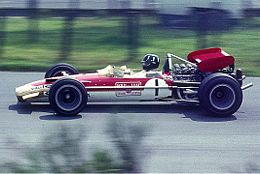Lotus 49C
 |
|||||||||||
| Category | Formula One | ||||||||||
|---|---|---|---|---|---|---|---|---|---|---|---|
| Constructor | Lotus | ||||||||||
| Designer(s) |
Colin Chapman (Technical Director) Maurice Philippe (Chief Designer) |
||||||||||
| Predecessor | Lotus 43 | ||||||||||
| Successor | Lotus 63 / Lotus 72 | ||||||||||
| Technical specifications | |||||||||||
| Chassis | Aluminium monocoque | ||||||||||
| Axle track | 152.4 Front and Rear | ||||||||||
| Wheelbase | 2,413 mm (95.0 in) | ||||||||||
| Engine | Ford Cosworth DFV, 2,998 cc (183 cu in), V8, NA, mid-mounted | ||||||||||
| Transmission | Hewland-Lotus 5-speed manual gearbox | ||||||||||
| Weight | 501 kg (1,105 lb) | ||||||||||
| Fuel | Esso (9 GP), Shell | ||||||||||
| Tyres | Firestone, Dunlop | ||||||||||
| Competition history | |||||||||||
| Notable entrants |
Gold Leaf Team Lotus Rob Walker Racing Team |
||||||||||
| Notable drivers |
|
||||||||||
| Debut | 1967 Dutch Grand Prix | ||||||||||
|
|||||||||||
| Constructors' Championships | 2 (1968, 1970^) | ||||||||||
| Drivers' Championships | 2 (Graham Hill, 1968 / Jochen Rindt, 1970) | ||||||||||
The Lotus 49 was a Formula One racing car designed by Colin Chapman and Maurice Philippe for the 1967 F1 season. It was designed around the Cosworth DFV engine that would power most of the Formula One grid through the 1970s. It used its drivetrain as a stressed member, being not the first F1 car to do so but the first to apply the technique so well that everyone copied it.
Jim Clark won on the car's debut in 1967, and it would also provide him with the last win of his career in 1968. Graham Hill went on to win that year's title and the car continued winning races until 1970.
After a difficult first year for Lotus in the 3-litre formula, Chapman went back to the drawing board and came up with a design that was both back to basics, and a leap ahead. Taking inspiration from earlier designs, particularly the Lotus 43 and Lotus 38 Indycar, the 49 was the first F1 car to be powered by the Ford Cosworth DFV engine after Chapman convinced Ford to build an F1 power-plant.
The 49 was an advanced design in Formula 1 because of its chassis configuration. The specially-designed engine became a stress-bearing structural member (seen earlier with the H16 engine in the Lotus 43 and BRM P83, but prior to that in the front-engined Lancia D50 of 1954), bolted to the monocoque at one end and the suspension and gearbox at the other. Since then virtually all Formula 1 cars have been built this way.
The 49 was a testbed for several new pieces of racecar technology and presentation. Lotus was the first team to use aerofoil wings, which appeared partway through 1968. Originally these wings were bolted directly to the suspension and were supported by slender struts. The wings were mounted several feet above the chassis of the car for effective use in clean air, however after several breakages which led to near fatal accidents, the high wings were banned and Lotus was forced to mount the wings directly to the bodywork.
...
Wikipedia
